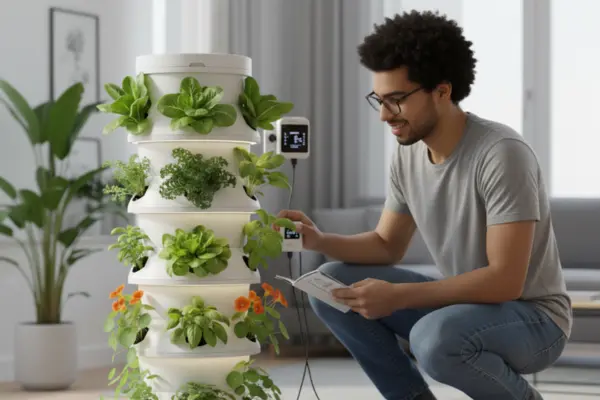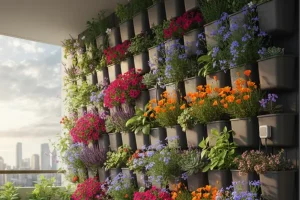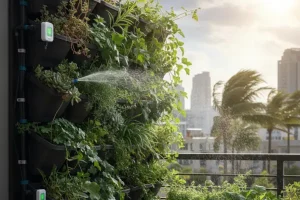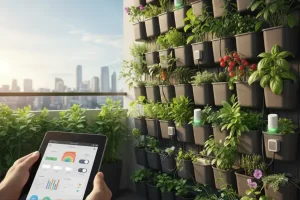One of the biggest challenges with gardening isn’t planting—it’s keeping up with the routine care. Watering, feeding, and adjusting light levels can quickly feel like a full-time job. The good news is that modern tools make it possible to automate your vertical garden so it practically runs itself.
With the right timers, pumps, and controllers, you can ensure your plants get consistent care without daily effort. Whether you travel often, have a busy schedule, or simply want peace of mind, automation can turn your vertical garden into a reliable, low-maintenance system.
Why Automation Matters
Automation isn’t just about convenience—it’s about consistency. Plants thrive when their needs are met on schedule. Skipping even one day of watering in a hydroponic or vertical system can cause stress, while overwatering can damage roots. Automation helps you:
- Prevent plant stress from inconsistent care
- Save time and effort
- Reduce human error
- Grow healthier plants with fewer setbacks
Essential Tools for Automation
1. Water Pumps
A submersible pump is the heart of any hydroponic or automated vertical system. It circulates water (and nutrients, if hydroponic) to every plant pocket.
What to look for:
- Energy efficiency
- Adjustable flow rate
- Easy-to-clean filter
- Backup option in case of power failure
2. Timers
Timers control when and how long your pump, lights, or fans run. They eliminate guesswork and keep cycles consistent.
Types:
- Mechanical timers: Affordable and simple, but less precise.
- Digital timers: Allow customized schedules and greater accuracy.
3. Nutrient Dosing Systems
For hydroponic systems, automatic dosing machines measure and add nutrients to the water. This keeps plants well-fed without constant monitoring.
4. Grow Lights with Timers
If your vertical garden is indoors, automated lighting is essential. A timer mimics the natural cycle of day and night, keeping plants on schedule.
5. Smart Controllers
Smart controllers integrate pumps, lights, fans, and sensors into one system. Some connect to your smartphone, allowing you to monitor and adjust settings remotely.
Step-by-Step Setup
- Install the pump inside the reservoir.
- Connect tubing to distribute water throughout the vertical tower.
- Attach a timer to the pump, setting watering intervals (for example, 15 minutes every 2–3 hours).
- Set grow lights on a timer (12–16 hours per day depending on crop).
- Optional: Add a nutrient dosing system to maintain balanced levels.
- Optional: Upgrade to a smart controller for remote access and automated alerts.
Sample Beginner Setup (Under $100)
| Component | Approximate Cost | Purpose |
| Submersible pump | $25–$35 | Circulates water |
| Digital timer | $15–$20 | Controls watering cycles |
| Clip-on LED grow light | $30–$40 | Provides consistent light indoors |
| Basic tubing + fittings | $10–$15 | Delivers water to plants |
This simple system is enough to keep a small vertical tower running smoothly with minimal daily effort.
Common Mistakes to Avoid
- Overcomplicating the Setup
Many beginners try to automate everything at once, which leads to frustration. Start simple with a pump and timer, then expand gradually. - Improper Watering Cycles
Too much water can drown roots; too little can dry them out. Begin with short, frequent cycles and adjust based on plant health. - Ignoring Power Backup
Pumps and timers depend on electricity. A sudden outage can stop water circulation and harm plants. Keep a battery backup or spare pump handy. - Neglecting Regular Maintenance
Automation reduces workload, but it doesn’t eliminate maintenance. Clean pumps, tubing, and filters every few weeks to prevent clogs.
FAQs
Q: Can I automate a soil-based vertical garden?
Yes. Timers can control drip irrigation systems for soil just as effectively as for hydroponics.
Q: Do I need a smart controller?
Not necessarily. A pump and timer are enough for most beginners. Smart controllers are helpful for large or advanced setups.
Q: How often should my pump run?
It depends on your system and plants. A common cycle is 15 minutes on, 2–3 hours off. Adjust as needed based on plant health.
Q: Can I monitor my garden remotely?
Yes. Many smart controllers and Wi-Fi timers allow remote monitoring and adjustments through a smartphone app.
Next Steps & Related Reading
Once your system is automated, the next challenge is long-term upkeep. See the Seasonal Maintenance Checklist for Vertical Growing Systems for tips on keeping everything in top shape throughout the year.
If you’re still planning your setup, compare Low-Cost Vertical Garden Systems You Can Build in a Weekend to decide which design works best before adding automation.
Conclusion
Automating your vertical garden doesn’t need to be complicated or expensive. With a basic pump and timer, you can create a system that provides consistent watering and light, freeing you from daily chores while ensuring healthier, more productive plants.
As you gain experience, you can add nutrient dosing systems and smart controllers for even more convenience. Start simple, expand as needed, and enjoy the peace of mind that comes with a self-sufficient vertical garden.
Which part of your garden would you like to automate first—watering, lighting, or nutrients?




